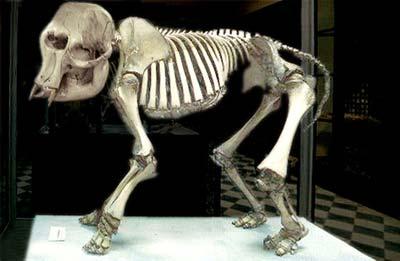Source:
03-02-2009 15:23
Ancient civilizations
The Maltese islands were first settled in 5200 BC by stone age farmers who had arrived from the larger island of Sicily, possibly the Sicani. The extinction of the dwarf hippos and dwarf elephants has been linked to the earliest arrival of humans on Malta.
 |
| Prehistoric pygmy elephant, discovered in Għar Dalam |
The Sicani were the only known tribe known to have inhabited the island at this time and are generally regarded as related to the Iberians. The population on Malta grew cereals, raised domestic livestock and, in common with other ancient Mediterranean cultures, worshiped a fertility figure represented in Maltese prehistoric artifacts as exhibiting the large proportions seen in similar statuettes, including the Venus of Willendorf.
Pottery from the Għar Dalam phase bares similarities with pottery found in Agrigento, Sicily. This earliest period of Maltese civilization was either supplanted by, or gave rise to, a mysterious culture of megalithic temple builders. The surviving monuments they constructed on Malta and Gozo the oldest standing stone structures on Earth. The temples were used from 4000–2500 BCE and were constructed with a distinctive architecture, typically a complex trefoil design.
There is some evidence that their rituals included animal sacrifice, however accurate information from this period is tentative. The culture appears to have disappeared from the Maltese Islands around 2500 BCe. Historians and archeologists speculate that the temple builders fell victim to famine or disease. War is discounted as a likely cause and archeological digs on Malta have yielded little or no evidence of weapons.
During 3500 BC, these people built some of the oldest free-standing structures in the world in the form of the megalithic Ġgantija temples on Gozo, other early temples include those at Ħaġar Qim and Mnajdra. Thereafter, the Maltese Islands were depopulated for several decades until the arrival of a new influx of Bronze Age immigrants, a culture that cremated its dead and introduced smaller megalithic structures called dolmens to Malta.
Around 700 BC, the Ancient Greeks settled on Malta, especially around the area now occupied by Valletta. A century later, Phoenician traders, who used the islands as stop on their trade routes from the eastern Mediterranean Sea to Cornwall, joined the natives on the island.
After the fall of Phoenicia, in 400 BC the area came under the control of Carthage, a former Phoenician colony. During this time the people on Malta mainly cultivated olives and carobs, and produced textiles.
